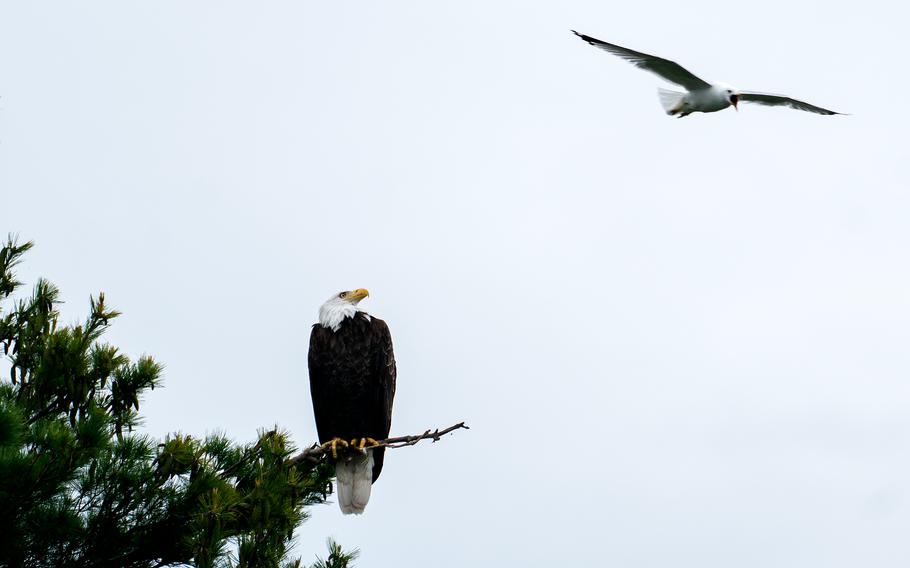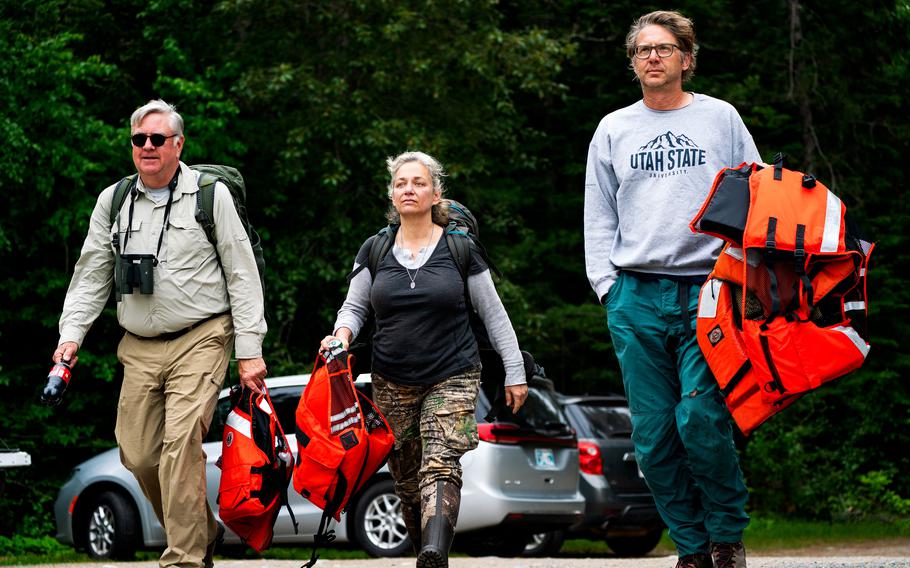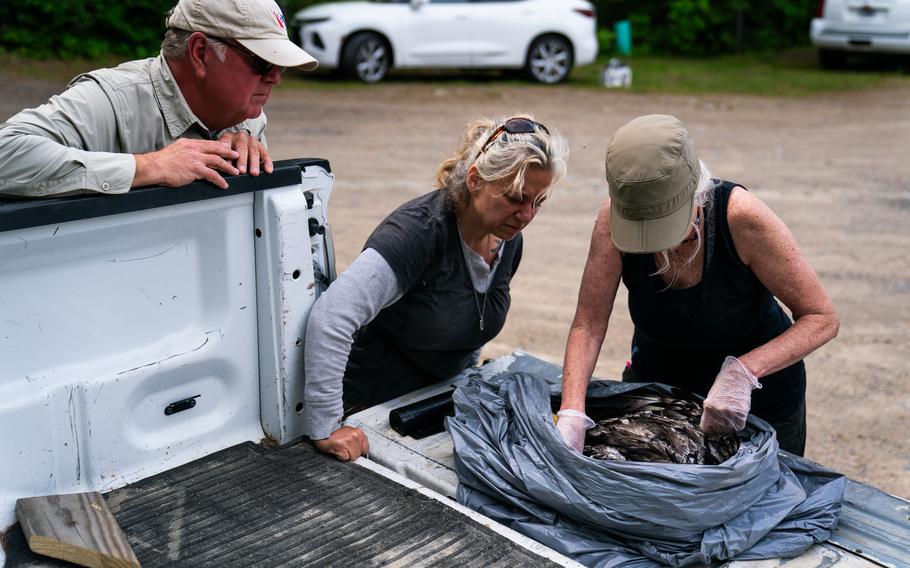U.S.
In eagle nirvana, avian flu is decimating America’s national bird
The Washington Post October 6, 2024

This eagle, harassed by a seagull, is a survivor at a time when, nationwide, avian influenza has killed at least 600 bald eagles in 45 states. (Demetrius Freeman/The Washington Post)
INTERNATIONAL FALLS, Minn. — The research boat thumped over the waves on a crisp June morning, spraying William Bowerman as he peered into 136 square miles of lakes and a cerulean sky in Voyageurs National Park.
“This is my favorite day of the year, because I’m here in eagle nirvana,” said Bowerman, a bald-eagle researcher who has been coming to these waters for half of his 63 years.
He spoke nostalgically of recent summers when you could scale a 70-foot white pine, peer over the edge of a massive nest and observe healthy brown eaglets. And from that perch, you could see the next eagle nest a mile away, and beyond it a third.
But as Bowerman and his colleagues monitored the status of the park’s bald eagles on this perfect morning, they were finding no young birds - just empty nests and the occasional adult.
Seventeen years after the Fish and Wildlife Service removed the bald eagle from the endangered species list, signaling the comeback of an iconic species, a new enemy is stalking our national bird. Not lead from duck-hunter bullets, not DDT from insecticides, not PCBs from industrial polluters.
The enemy this time is avian influenza.
In Northern Michigan, where Bowerman, a University of Maryland professor, has spent 40 years continuing a long-running bald-eagle census, the number of occupied eagle nests had risen from 52 in 1961 to 114 in 1984 and about 1,000 by the end of 2021. Late that year, highly pathogenic avian influenza reached North America.
The impact was immediate and devastating. In 2022, the number of occupied nests plunged 50 percent. Tests on dead bald eagles performed by the Michigan Department of Natural Resources revealed that 38 percent of those that could be diagnosed had died of avian influenza.
In Minnesota, however, there are no comprehensive figures on the impact of the disease because the state does not collect all dead eagles for necropsy, the animal version of an autopsy.
Nationwide, avian influenza has killed at least 606 bald eagles in 45 states, according to findings from the Animal and Plant Health Inspection Service, part of the Department of Agriculture. And those are just the eagles whose remains have been recovered and tested; experts believe they represent only a small fraction of the true toll.
“The warning bell has been rung,” said Peter Nye, who started organizing New York state’s bald-eagle restoration program in 1975 when the state had just a single pair. When he retired in 2010, the number had risen to an estimated 450.
In Florida and Georgia, avian influenza has caused an alarming rate of bald eagle deaths and nest failures, researchers wrote in January 2023 in the journal Nature Scientific Reports. Nest success rates - the percentage that result in the birth of eaglets that learn to fly - dropped in the two-hardest hit Georgia counties, Camden and Glynn, by 43 percent and 62 percent respectively in 2022.
Eagles were nesting when the virus began to overrun the population.
“Waterfowl were dying, and the eagles were eating the waterfowl,” said Nicole Nemeth, lead author of the paper and head of the research and diagnostic service at the Southeastern Cooperative Wildlife Disease Study at the University of Georgia. The study, launched in 1957, receives dead wildlife from 17 states and has helped researchers evaluate the broader impact of avian influenza.
As dead eagles came into the study in 2022, the organizers heard the same basic story again and again.
“‘This was a nesting adult. We found it dead. A day or two later, we found the mate dead, and then the chicks died.’ It was sad, depressing, alarming,” Nemeth said. “It was like you were trying to sleep at night, and you just could not get out of your mind the fact that these birds were dropping dead.”
In a graphic video accompanying the journal study, an eagle infected with avian influenza jerked its head frantically and beat its wings, unable to rise more than a few feet from the ground.
Nemeth and her colleagues concluded that the eagle losses from avian flu offer a broader picture of the disease’s impact, “an early horizon scan of an emerging threat to populations of predatory and scavenging birds across North America.” Hundreds of hawks and owls have already been felled by the disease, according to federal figures.
So far, the threat to humans from avian influenza has come not from wild birds but mostly from domestic poultry and herds of dairy cows overrun by the virus. Still, approaching a diseased eagle, one thrashing its wings or shaking its head, may put a human at risk of becoming infected from aerosolized virus, said Richard J. Webby, a virologist at St. Jude Children’s Research Hospital in Memphis.

Bald-eagle researcher William Bowerman, left, and biologists Peggy Shrum and Michael Wierda head out for a second day searching for eagles and their offspring at Voyageurs park on June 15. (Demetrius Freeman/The Washington Post)
For bald-eagle conservationists, the virus threatens to reverse decades of progress.
In 1963, bald eagles were lurching toward extinction, reaching an all-time low of 417 known nesting pairs in the Lower 48 states, according to the nonprofit American Eagle Foundation. Conservation efforts helped the population recover, reaching an estimated 316,700 individual bald eagles and 71,400 nesting pairs as of 2020.
Researchers first isolated H5N1 avian influenza in 1959 in Scotland after an outbreak in chickens, according to the Centers for Disease Control and Prevention. The contemporary version that is killing American bald eagles was discovered in Chinese geese about 1996.
Although the United States faced a major outbreak of avian influenza in 2014 and 2015, it did not involve the H5N1 strain.
Historically, wild birds and migratory waterfowl have been natural reservoirs for avian influenza, meaning they carry and can spread the virus but don’t usually show symptoms, said Julianna Lenoch, national wildlife disease program coordinator for the Animal and Plant Health Inspection Service.
“In this outbreak,” Lenoch said, “we are seeing vast amounts of disease and death in wild bird populations around the world.”
It is not clear why this outbreak of avian influenza has taken such a heavy toll on wild birds.
Researchers know that when they find nests without any eaglets, there are many possible explanations. Some die in territorial disputes with rival eagles; high winds blow other young out of their nests. Bears climb trees and eat the nestlings. Great horned owls swoop down and decapitate them.
And one-third of mating pairs fail to produce young for natural reasons.
The researchers in Voyageurs National Park believed H5N1 to be the most likely cause of what they were witnessing.
“Damn,” said researcher Mike Wierda hours into the first day’s work at Voyageurs. “It doesn’t seem right.” “It isn’t right,” Bowerman said.
“Lovely boat ride and everything, but it’s kind of depressing,” said Wierda, an associate professor in extension with Utah State University. Wierda’s job that day was to climb trees, delicately gather nestlings one at a time, then lower them in special bags to the ground. There, colleagues would band them and take blood and feather samples for testing.
On a good day, he climbs more than half a dozen trees. On this day, it was not until late in the afternoon that Wierda hauled himself up his first tree. Forty feet up a white pine lay a nest that seemed a long shot. Researchers staring through binoculars had not glimpsed a flapping wing, a thick brown beak, anything to indicate the presence of a nestling, aside from bird waste, known as whitewash.
“I’m feeling optimistic,” Wierda remarked as he scaled the tree about 10 feet below the nest. A few minutes later he peered over the nest’s lip. “There’s nothing up here,” he said.
Bowerman asked him to look inside the nest for eggs, but Wierda saw none.
“In a bad year,” Bowerman said, “I’d have eight [nestlings] banded by the end of a day. I don’t know what I’m going to have today.”
About 5 p.m., the researchers pulled their boat up to the dock. The nestling total for the day: zero.
“I’ve never had a day like this,” Bowerman muttered in a voice full of sadness. Although he did not see his first bald eagle until the age of 16, the raptors have had an almost spiritual hold on him.
“For me,” he said, “seeing an eagle in a tree, soaring overhead, catching a fish, feeding their young, never gets old. Their beauty and their presence in the environment means that it is a healthy place on the earth.”
On the second day, Lee Grim, a retired National Park Service biologist, guided the research boat past some of the park’s more than 500 islands, rattling off the histories of virtually every nest, as the team searched for eaglets. The sky was cloudy, the mosquitoes plentiful.
There was a nest on Pine Island, but the tree was dead, making it too dangerous to climb. A large tree branch supporting a nest on Sphunge Island was torn away by high winds and took the nest with it. Now, an adult eagle perched nearby, no young in sight.
Shortly before lunch, Grim steered the boat past an area where he spotted eagles earlier this year. Now, he could not find them. As the boat approached Cutover Island, researchers peered through their binoculars at a nest about 65 feet up a white pine.
“We’ve got a head,” Bowerman shouted. “Hallelujah. It’s only my second day in eagle nirvana, and we’ve found an eaglet.”
Wierda climbed the white pine as an adult eagle kept watch from a nearby tree. The two eaglets edged out from the nest onto a tree branch, and Wierda feared they might jump. When spooked, older eaglets will sometimes plunge from a tree before they are able to fly. Wierda determined these eaglets were too old to handle safely.
On the ground, members of the team learned that a dead adult eagle had been found in water near the shoreline about 1.2 miles north of Bivo Island. It would be examined and tested to determine the cause of death. Wierda climbed down, the team returned to the boat and the search continued.
A few minutes later as they circled Cutover Island, Peggy L. Shrum, the lead field biologist, spotted a previously undocumented nest.
“Good eyes!” Bowerman shouted. Once again, Wierda donned his climbing gear. Nearby, another researcher found a promising sign of an active nest: the discarded, mostly skeletal remains of a walleye, a freshwater fish in the perch family.
When Wierda looked into the nest, this time he saw two eaglets. They were the right size for banding and testing.
As Wierda lowered the first eaglet in a blue wildlife bag, a call went out: “Baby coming. Baby coming.”
On the ground Shrum, who lives in Greenville, S.C., lay the eaglet on its back, and Whitney Gouin, a 22-year-old field fellow for the Park Service’s aquatic ecology team, held its scaly yellow feet, carefully avoiding the sharp, black talons. The bird’s light brown feathered chest rose and fell rapidly.
“It’s okay, sweetie. It’s okay,” Shrum said softly.
Shrum took a small vial of blood and some feathers, which can be used for mercury analysis. She recorded its sex - male - and wrote down measurements, including its foot pad and bill depth.
The bird weighed just 7.3 pounds; his sister weighed 11.
“We know who’s getting the hamburger,” Shrum said.
After the measurements and samples were taken, the young eaglets were bagged, pulled by rope up the tree and returned to their nest.

Bowerman; Julia Ponder, an associate dean of the College of Veterinary Medicine at the University of Minnesota, center; and Shrum inspect a grim discovery: the remains of an adult eagle. (Demetrius Freeman/The Washington Post)
A couple of hours later, the team returned to the dock. Although there are no official numbers kept of eagle nests in the park, Bowerman estimates there were about 53 breeding areas in 2022. Preliminary results from 2024, he said, appear to show a decline of 68 percent.
Initial examination of the dead eagle revealed bloody puncture wounds in the upper cheek and neck, a sign that the raptor may have died after a territorial fight with another eagle, said Julia Ponder, an associate dean of the College of Veterinary Medicine at the University of Minnesota, adding, “So, it might not be avian influenza.”
In fact, it was not avian influenza; the eagle did not have the virus, testing at the University of Minnesota Veterinary Diagnostic Laboratory later confirmed.
The news was not all bad, Bowerman said. “A bonus nest that we didn’t know existed had chicks.”
A small measure of joy in eagle nirvana.